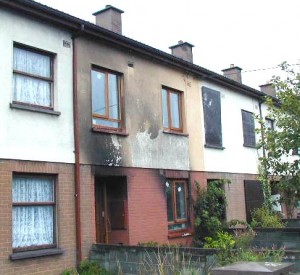2012-11-28: On Monday last, 26 November 2012 … Fire broke out at a Sheltered Workshop for People with Activity Limitations, located in the small municipality of Titisee-Neustadt, south-western Germany … not too far from the borders of France and Switzerland. It was approximately 14.00 hrs in the afternoon … in broad daylight.
German news reports put the death toll at 14 People, including 1 Carer … with 10 People injured.
News reports also state that it took 2 Hours for Firefighters to bring this incident under control. At the time that Photograph 1, below, was taken … smoke had spread throughout a major part of the building.
Viewers should look closely at the top of the external staircase … then, ask yourselves how any person with an activity limitation can be safely rescued, or assisted to evacuate, by means of a ladder (obscured, at the end of the building on the left) … and, finally, notice the positioning of fire hoses on the ground and on the staircase … some of the many issues which have been discussed extensively here before …
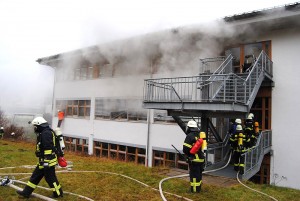
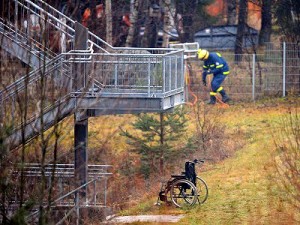
.
2005 NIST(USA) Final Report on 9-11 World Trade Center 1 & 2 Tower Collapses
– Recommendation #17b –
To the degree possible, people with activity limitations should be provided with a means for self-evacuation in the event of a building emergency. Current strategies (and law) generally require these people to shelter-in-place and await assistance. New procedures, which provide redundancy in the event that the fire warden system or co-worker assistance (e.g. the buddy system) fail, should consider full building evacuation, and may include use of fire-protected and structurally hardened elevators, motorized evacuation technology, and dedicated communication technologies.
.
At the heart of the impressive show of fire fighting equipment and technology … and the usual reassuring statements by local officials and other people in authority after the event … there is an equally impressive lie …
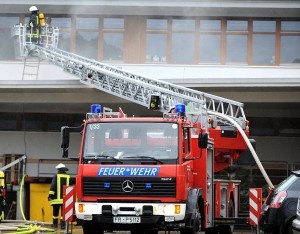
Current Building Codes and Regulations, Fire Safety Standards, Building Design Practices, and Building Management Procedures … do not seriously consider the safety of People with Activity Limitations … not properly – not adequately – not even INadequately. Tokenism is the best offer available in just a few European countries.
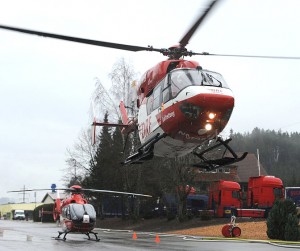
According to Spiegel OnLine International …
The rescue was difficult because some people panicked, said Local Fire Chief Alexander Widmaier. “We are dealing here with people who naturally do not respond rationally”, he said.
IF this is an accurate news report, and bearing in mind that it is also a translation … I SAY …
Let us be generous and kind … Local Fire Chief Alexander Widmaier has NO awareness or understanding of People with Activity Limitations and the daily challenges they face in moving around and using a built environment which is inaccessible and unsafe.
According to AFP OnLine …
Gotthard Benitz, of the Titisee-Neustadt fire service, told AFP earlier that the fire began on the ground floor of the building which also had a basement and an upper floor.
“The victims were all on the same floor where the fire was”, he said adding this was the only area to have sustained fire damage and the stairwell had remained smoke-free meaning those on the other two floors had been able to use it.
He also said firefighters were prepared for dealing with an emergency at the workshop as practice fire alarms were regularly carried out there, with the last one having been last year.
The head of Caritas in Germany, Peter Neher, told ZDF public television that emergency practice drills were done regularly.
IF this is an accurate news report, and bearing in mind that it is also a translation … I SAY …
Gotthard Benitz should also look at the top of the external staircase in Photograph 1 above. IF there are no circulation hazards, e.g. ice, or obstacles, e.g. fire hoses … able-bodied people can easily go up or down a staircase … people who use wheelchairs or other mobility-aid devices cannot.
In their respective positions of responsibility … Gotthard Benitz and Peter Neher should both understand that all building occupants must be facilitated in acquiring the skill of evacuation to a ‘place of safety’, by way of a safe and accessible route. An emergency practice drill, although carried out regularly once a year … is ENTIRELY inadequate … and will achieve Very Little.
Skill: The ability of a person – resulting from training and regular practice – to carry out complex, well-organized patterns of behaviour efficiently and adaptively, in order to achieve some end or goal.
Standard fire evacuation training and practice drill procedures must be adapted to the individual-specific abilities of People with Activity Limitations.
.
BUT … the new International Standard ISO 21542 is a very small step in the right direction. See yesterday’s post.
This situation will only improve to a significant degree, however, when People with Activity Limitations, and their Representative Organizations, begin to act decisively, in unison, and with serious intent …
.
Self-Protection from Fire in Buildings – Personal Check List for People with Activity Limitations
1. Upgrade ‘My’ understanding of Accessibility …
Ease of independent approach, entry, egress, evacuation and/or use of a building and its services and facilities, by all of the building’s potential users – with an assurance of individual Health, Safety and Welfare during the course of those activities ;
2. Be assertive (not aggressive) with regard to ‘My’ own self-protection in emergency situations ;
3. Concerning ‘My’ safety … demand that Building Management actively engages in Meaningful Consultation – and receives your Informed Consent ;
4. Become familiar with the Fire Defence Plan for the building, and know ‘My’ part well ;
5. Practice – practice – practice … become skilled in evacuation to a Place of Safety ;
6. Become involved, and participate directly in the Building’s Safety Procedures.
.
Self-Protection from Fire in Buildings – Must-Do List for Representative Organizations & Groups
1. Upgrade ‘Our’ understanding of Accessibility in a Social Context, its Current Vocabulary, and its Complexity … groups of individuals wish to socialize together … this is now, afterall, a recognised human and social right !
Ease of independent approach, entry, egress, evacuation and/or use of a building and its services and facilities, by all of the building’s potential users – with an assurance of individual Health, Safety and Welfare, and group Wellbeing, during the course of those activities ;
2. Be assertive (and aggressive) with regard to the availability of proper Data and Statistics – we must clearly identify ‘Our’ problem with the many restrictions placed on our participation in local communities ;
3. Produce a working statement of an Individual’s Rights – on 1 Page (!) ;
4. Issue clear guidelines on Reliable Advocacy ;
5. Become involved, and participate directly in the improvement of Building Codes and Regulations, Fire Safety Standards, Building Design Practices, and Building Management Procedures ;
6. Demand resources to Monitor ‘Effective’ Implementation … and Target Relevant and ‘Practical’ Research.
.
.
END


